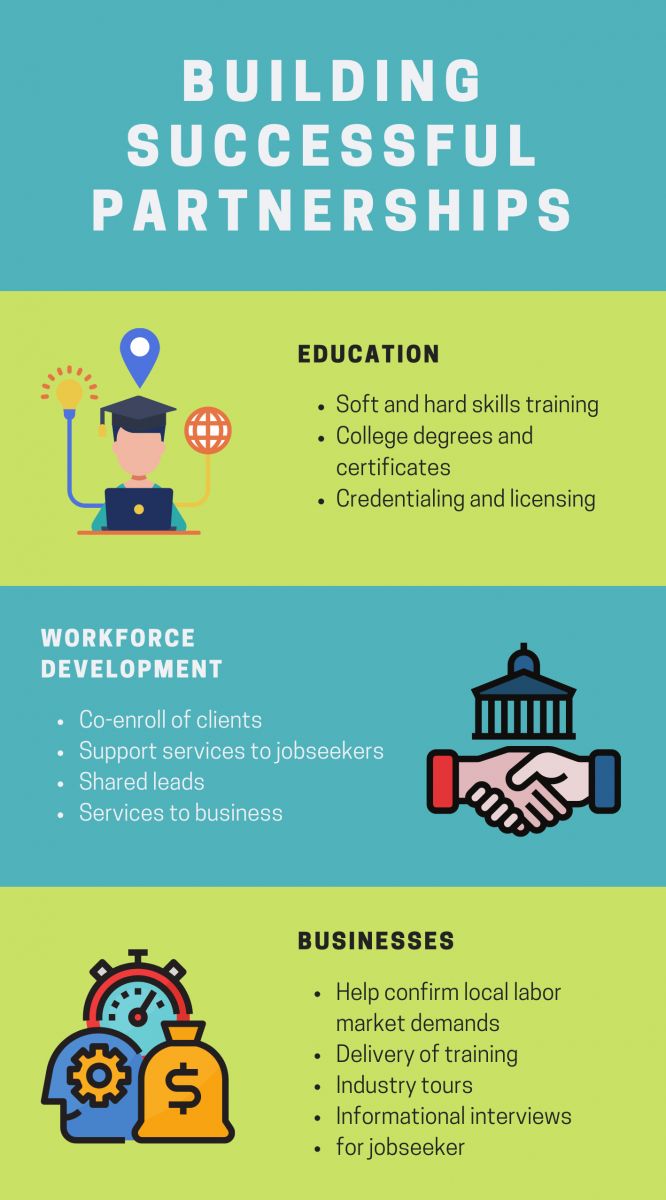As of 2014, the Workforce Innovation and Opportunity Act (WIOA) requires that states strategically align workforce development system programs such as VR, education, workforce partners, and others partners like Career Pathway Boards to ensure that employment and training services provided are coordinated so that job seekers acquire skills and credentials that meet business’ needs. Other partners engaged in these efforts include human services, veterans and Tribal government. States use multiple forums to bring partners together for system alignment and coordination on co-enrollment staffing, cross agency staff trainings, collection of common performance measures, Career Pathways advisory committees, and economic development/ local and regional meetings.
These endeavors are furthering partnerships at the local, regional and state level, supporting data-driven decision making and promoting a vision of and strategies for sector partnerships and career pathway systems. There are multiple opportunities to coordinate efforts on a variety of related activities such as Reserve Job Fairs, industry events , co-enrolling job seekers, trainings, worksite visits, and tours of educational institutions that benefit the partners, businesses and job seekers. View an example of a manufacturing event checklist (PDF) (Word).
Education
Education partners include institutions for higher education, adult education programs, secondary education for transition age youth, and business-driven, short-term, hands on trainings. Trainings may focus on both technical hard skills and soft skills, giving workers the opportunity to acquire the skills they need to pursue in-demand jobs and careers. With the focus on attainment of skills and credentials needed to meet the labor market demands, education partners play a pivotal role in career pathways.
As noted earlier, career pathway approaches provide multiple entry and exit points and depending on the jobseeker’s skillsets and the sector they are pursuing, the training delivery may be outside of traditional settings. Regular communication and coordination around IPE plans and career exploration activities is essential for transition-age youth career pathways. Four-year universities and community colleges continue to be the primary systems for completion of associate, bachelors, masters and Ph.D. degrees.
Along with community colleges, community-based training programs and businesses often conduct customized training, trade and technical certificate programs in areas such as welding, HVAC, CNA, logistics and automotive. These partners are also involved in pre-apprenticeship and apprenticeships programs. VR can be a valuable partner and asset to education providers because of their disabilities expertise. Typical services renders include O&M/low vision training, disability etiquette and guidance on addressing hidden disabilities.
Related resources:
- A two-page flyer (PDF) (Word) for the Central Nebraska Manufacturing Program intended for schools. It contains information about the training, salaries for different entry-level manufacturing positions, and the public partner agencies involved in this project.
Workforce Development
The workforce system supports strong regional economies and plays an active role in community and workforce development. A major tenet of WIOA is to improve employment service delivery to individuals with disabilities by increasing access to high quality workforce services. With the advent of the new regulations, VR and American Job Centers in many states are moving towards co-enrollment of clients, shared business leads through business account managers, and in some cases being co-located. This level of partnership extends to and reinforces their joint work on career pathways. CPID indicators on wage, credential attainment and measurable skill gain align well with WIOA performance indicators.
Other federal and community partners can also serve important roles in the development and implementation of Career Pathway approaches. They may be at the table working with businesses through local chambers of commerce or SHRM. They may deliver support services to jobseekers such as transportation, medical and mental health treatment, benefits planning, interpreter services, and other social services. Inclusion of and coordination of services will create the needed infrastructure for successful implementation of Career Pathways.
Businesses
Businesses serve various roles in career pathways. They are the recipients of services from multiple partners in accordance with the dual customer approach. They are also a core partner in the development and implementation of career pathway approaches. For example, many businesses are involved in the delivery of training. They participate in industry-specific academies and industry tours, conduct informational interviews for jobseekers, and discuss credentials needed within the career pathways. Businesses also assist job seekers in understanding entry and exit points as it relates to their industry.
Businesses frequently request a unified business engagement approach in outreach and delivery of services to them. VR and other partners are joining efforts to coordinate, share leads and identify a single point of contact (Business Relations Specialist / Business Account Managers) to assist in working with businesses to develop partnerships and customized training programs. VR is in a unique position of being the disability expert. They can offer lean accessibility program assessments and/or ergonomic assessments, assistive technology, provide trainings on Section 503, ADA, Disability Awareness and Disability Etiquette (PPT), and can assist in retention and advancement of incumbent workers with disabilities.


